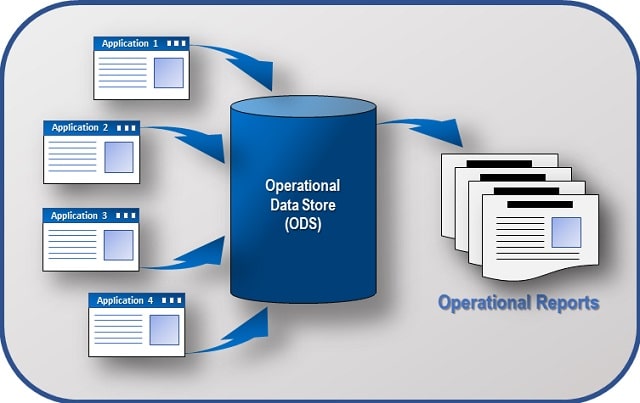
Database sizes are increasing all the time and to reap its benefits, companies need to find ways to process data with as little disruption to business operations as possible. With the growing demand for speed, low latency and scalability, new solutions are necessary to help solve challenges.
Collecting and storing data is useless unless companies can use it to achieve business objectives. An Operational Data Store (ODS) can be a real benefit, especially if it is a next-generation ODS rather than a traditional one.
1. A Consolidated Repository For Previously Isolated Systems
An Operational Data Store integrates data coming from a variety of different sources and puts it in consistent format while business operations continue. It, therefore, provides a consolidated repository for previously isolated systems of record. According to GigaSpaces, the main advantages of integrating data from the various systems of record is for analysis and reporting.
Business owners and employees can make more informed decisions by having a more comprehensive view of data than when it is siloed in the different systems of record. The integrated tables contain the most recent, relevant snapshot of operational activities and therefore, reports on operational processes are more sophisticated and holistic than reports coming from individual systems.
2. Real-Time Processing
One of the problems when dealing with huge quantities of data is high latency. Making API calls to various data sources for each action makes real-time processing impossible and customers are unable to get the response times they demand today. An ODS focuses on a single business concept, such as a customer, service or product and constantly updates data, overwriting previous data.
As the data is in real-time or as close to real-time as possible, it enables excellent operational decision-making. For example, creating a marketing plan today involves using real-time data to target customers and hone in on their preferences and needs. Data analysis can also help with monitoring performance and improving marketing campaigns.
3. Very Fast Performance
A next-generation ODS uses a distributed in-memory core and this means back-end systems are unaffected by unplanned loads or unexpected volumes. Over-provisioning with expensive resources when volumes fall is inefficient and this becomes unnecessary with an ODS in place.
The ability to scale autonomously means that companies can maintain customer experience when volumes peak and a high concurrency of users does not affect performance at all.
4. High Availability
When many systems of record need managing, the chance of a system of record going down is high. Decoupling the API layer from the systems of record means applications can continue working even when a particular system of record isn’t available.
For example, checking the credit card status of a customer against the ODS is possible without having to interrogate an authorization system that may be down. Customers today expect 24/7 service and are not satisfied if service is disrupted for any reason.
5. Better Predictive Modeling
When real-time or near real-time data is available for analysis, predictive modeling is more robust and accurate. Predictive modeling is a process used by businesses, involving the use of data and statistics to predict outcomes. Forecasting outcomes can reduce time, efforts and costs.
For example, businesses can predict potentially late deliveries, sales orders, and other impacts or risks. Variables such as regulation changes, market conditions and environmental factors can be factored into calculations to offer more complete views.
6. Easier Diagnosis Of Problems
By having a current view of operational status, users can diagnose problems without having to go to individual systems of record. For example, a service rep could find a customer order and determine its status quite easily.
7. Time-Sensitive Business Rules
Businesses can build time-sensitive business rules on an ODS. They can automate certain processes and improve business efficiency. Without current, integrated operational data, this would be impossible. The rules engine can recommend a certain action to an appropriate system for execution. For example, if fraud is suspected, an authorization system may be alerted to take an appropriate action.
8. Remote Data Center Synchronization
Global organizations often have data centers in remote sites due to the need to keep to certain regulations and offer high availability. An ODS makes it possible to synchronize remote data centers and allow for cross-site replication in real-time. Data synchronization ensures secure, accurate and compliant data and successful customer experiences.
Clean, consistent data is essential for product and service competence but also for data governance issues like regulatory compliance. Without seamless synchronization, data transactions can be delayed, and decisions can be affected by inaccurate data. A glitch can also have a negative impact on customer retention and sales. An ODS allows for unaffected performance and accurate decision-making.
9. Effective Security
With mobile apps and the rise of online transactions, security issues such as data breaches and cyberattacks are on the increase. Data privacy regulations are stricter than before and organizations need to secure even their internal systems.
A modern ODS can effectively support role-based security, data masking and advanced encryption systems. Only a few people have security to access systems of record but an ODS doesn’t have the same security issues as it doesn’t contain historical data.
10. Handles Data On-Premise And In The Cloud
Many organizations today have data on-premise and in the cloud. They adopt a hybrid solution so they can enjoy the benefits of each to the needs of the business. An ODS can handle data from many different sources without compromising performance. It can orchestrate data in real-time or near real-time from on-premise or in the cloud data sources. It doesn’t matter what systems data comes from or where it is stored.
A Final Word On Operational Data Stores
Companies choosing to modernize their architecture with a next-generation ODS will drive their digital transformation and improve their throughput and scalability dramatically. They can upgrade their operational capabilities as an ODS enables better decision-making and reporting. By becoming more productive and efficient with company data, they can maintain a competitive edge and stay profitable.
